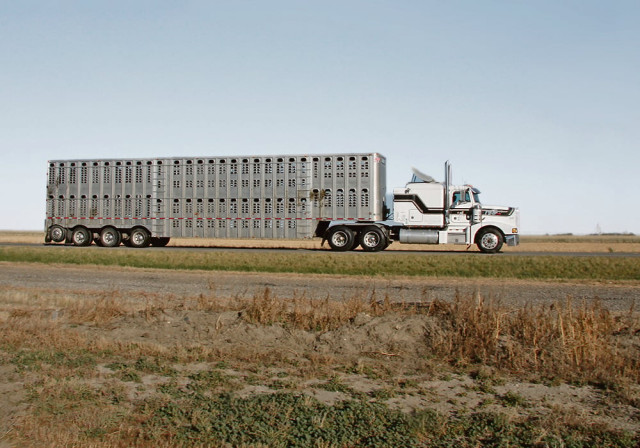The Canadian livestock sector wants flexibility in the enforcement of truck driver hours-of-work rules to account for unforeseen circumstances.
Animal transporters said they don’t want to be fined for taking animal welfare into consideration if they are unexpectedly delayed and exceed the maximum 13 hours of truck operation per day.
However, Transport Canada said the regulations already include flexibility and transporters should apply for an exemption instead.
Melanie Vanstone, director general of multi-modal and road safety programs at Transport Canada, said officials have met with the industry since the requirements for electronic logging devices (ELDS) were first proposed in December 2017.
The final regulations requiring ELDs instead of paper log books came into force in June 2021 but enforcement measures weren’t applied until January 2023.
She told the standing agriculture committee that truckers’ hours of work haven’t changed since 2007.
“The only change was that these hours must now be tracked electronically, which means they are less susceptible to errors or deliberate falsification,” she said.
Vanstone said the regulations, which provincial authorities enforce, allow exemptions for those who work within 160 kilometres of their home terminal, the ability to defer up to two hours of daily off-duty time and the ability to increase driving time by up to two hours in adverse conditions.
She said an exception can be granted if it’s found to be in the public interest and doesn’t affect motor carrier safety.
But livestock industry representatives said they are concerned about the safety of their live cargo.
They said ideally Canada would harmonize regulations with the United States, which allows unlimited hours for livestock haulers within a 150-air-mile, or about 270 kilometres, of the origin or destination of their load.
Canadian Pork Council chair Rene Roy said Transport Canada should update its guidance to address animal welfare.
“We are not seeking an exemption from hours of service requirements or from ELDs,” he said. “Instead, we are asking for flexibility in enforcement in unforeseen circumstances, and communication of this flexibility.”
Cathy Jo Noble from the National Cattle Feeders Association said drivers nearing the end of their hours sometimes have to decide whether to adhere to the hours-of-work requirements or deliver their loads. They plan their routes to include a time buffer but unforeseen circumstances, such as weather, a closed road because of an accident or a border delay, can affect that plan.
She said the guidance should allow an extension in an emergency.
Noble said Transport Canada asked for data that isn’t available, including the number of additional hours that would be required and how often it would happen.
“We cannot predict unforeseen delays until they happen,” she said. “What we do have are numerous first-hand examples of how regulations are unworkable for livestock transporters and the animals in their care.”
Beef Farmers of Ontario president Jack Chaffe said the feed, water and rest requirement that means loads have to stop at Thunder Bay could be compromised if a driver is delayed. There are no facilities along the route and no place to pull over.
David Fehr, chief financial officer at Van Raay Paskal Feeders in Alberta, said the company imports feeders from throughout the Pacific Northwest in the U.S. Drivers have to deal with multiple organizations and authorities and could encounter unforeseen delays anywhere.
Loads from Iowa, for example, are planned a week in advance with veterinarians on both sides of the border, sorting facilities and drivers, but he said sometimes things happen.
Even within loading yards, the ELDs start to record time at a speed of three m.p.h., he said. Also, loads often travel as a group and the first driver loaded may be using up time while waiting for the others.
“The driver has to choose what he’s going to take care of and at the end of the day he has a responsibility to care for the animals and that’s what his biggest priority is going to be,” said Fehr.
The committee heard that there are concerns about drivers having to stop in extremely hot weather, when ventilation through the truck would not be available.
Susan Fitzgerald from the Canadian Livestock Transporters Alliance said this applies to bees, too.
“Plus, with bees, there is the concern of bee escapes when stationary, which could become a human safety concern.”
She said live-haul drivers cannot simply pull into a rest area or go off-duty when they reach the maximum hours and said the U.S. regulations “recognize the unique aspects of transporting live animals and that provides the needed flexibility.”
She and Noble both said the industry wants guidance because decisions about enforcement should not be left to individual officers.
“Thus far Transport Canada officials have not indicated to us that they would move forward with this reasonable request,” said Fitzgerald.
Transport Canada’s Vanstone said the regulations are part of the national safety code maintained by the Canadian Council of Motor Transport Administrators.
The CCMTA’s compliance and regulatory affairs program committee was scheduled to discuss the issue last week.


